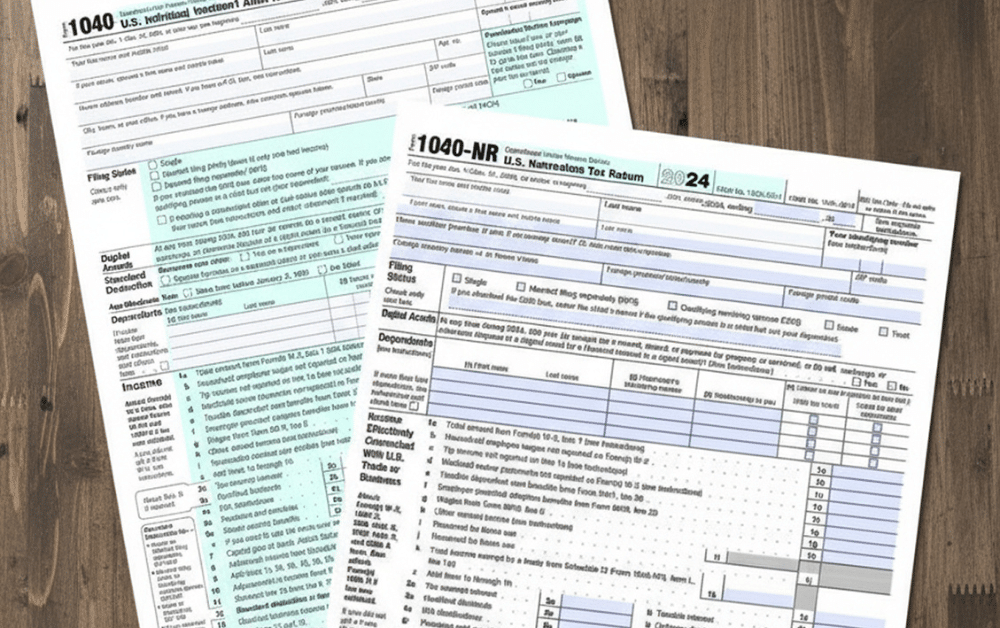Form 1040 vs Form 1040-NR: Which Tax Form Should I File?

- What's the Difference Between Form 1040 and Form 1040-NR?
- Form 1040 vs Form 1040-NR: Quick Comparison
- How Do I Know Which Form I Should File?
- Which Days Don't Count When Calculating My US Presence?
- What If I Changed My Residency Status During the Year?
- Which Form Should I Use for My Situation?
- What Happens If I File the Wrong Form?
- Do I Still Need to Report My Foreign Accounts?
- I'm a US Citizen Living Abroad. Which Form Do I File?
- When Is My Tax Return Due?
- What Are the Most Common Mistakes I Should Avoid?
- Get Expert Help With Your Filing Decision
If you’re physically present in the United States for at least 31 days in the current year and 183 days over a three-year period (using a weighted formula), you’ll likely file Form 1040 as a resident for tax purposes. But if you don’t meet these thresholds, you may need Form 1040-NR instead.
The key distinction is simple: your tax residency status determines which form you file. Form 1040 is for US citizens and resident aliens who report worldwide income, while Form 1040-NR is for nonresident aliens who only report US-sourced income. Immigration status doesn’t automatically determine tax status. Even temporary visa holders can be tax residents if they meet specific presence requirements.
What’s the Difference Between Form 1040 and Form 1040-NR?
The primary difference comes down to what income you report and which tax benefits you can claim.
Form 1040 requires you to report all income from any source worldwide. This means your salary from a US employer, freelance income from clients in Europe, rental property in Canada, and investment dividends from Asian markets all need to be included. However, you also get access to the full range of US tax benefits: standard deduction, earned income tax credit, child tax credit, education credits, and more. For 2025, the standard deduction is $15,000 for single filers and $30,000 for married filing jointly.
Form 1040-NR limits your reporting to US-sourced income only. If you earned a salary while working in the United States, received rent from US property, or had dividends from US investments, those need to be reported. But your foreign income stays off your US return entirely. The tradeoff is that you have limited access to deductions and credits. You cannot claim the standard deduction, and many tax credits available to residents are off-limits. You also cannot file jointly with your spouse unless they’re a US citizen or resident and you make a special election.
Filing the wrong form can lead to either overpaying taxes or facing penalties and delays from the IRS.
Form 1040 vs Form 1040-NR: Quick Comparison
| Feature | Form 1040 | Form 1040-NR |
|---|---|---|
| Who Files | Meet the green card test OR substantial presence test | Nonresident aliens with US-sourced income |
| Residency Test | Meet the green card test OR the substantial presence test | Don’t meet either test (or qualify for closer connection exception) |
| Income Reported | Worldwide income from all sources | US-sourced income only |
| Filing Status Options | Single, Married Filing Jointly, Married Filing Separately, Head of Household, Qualifying Surviving Spouse | Single or Married Filing Separately only (joint filing requires special election) |
| Standard Deduction | Yes ($15,000 single, $30,000 married filing jointly for 2025) | No |
| Itemized Deductions | Full access to all itemized deductions | Limited itemized deductions |
| Tax Credits | Full access (Child Tax Credit, Earned Income Credit, education credits, etc.) | Very limited (most credits unavailable) |
| Foreign Earned Income Exclusion | Yes (up to $130,000 for 2025) | No |
| Foreign Tax Credit | Yes | Limited |
| Filing Deadline (with wages) | April 15 (June 15 if abroad) | April 15 |
| Filing Deadline (no wages) | April 15 (June 15 if abroad) | June 15 |
| Extension Available | Yes, to October 15 | Yes, to October 15 |
| E-Filing | Yes | Yes (except dual-status returns) |
| Tax Treaty Benefits | May claim if applicable | May claim if applicable |
| FBAR Required | Yes, if foreign accounts exceed $10,000 | Yes, if foreign accounts exceed $10,000 |
| Form 8938 (FATCA) | Yes, if assets exceed the threshold | Yes, if assets exceed threshold |
How Do I Know Which Form I Should File?
You are a resident of the United States for tax purposes if you meet either the green card test or the substantial presence test for the calendar year.
Green Card Test
You’re considered a resident for US federal tax purposes if you’re a lawful permanent resident of the United States at any time during the calendar year. This status continues until you formally relinquish your green card or it’s administratively or judicially terminated.
If you received your green card at any point during the tax year, even on December 31, you’re considered a resident for that entire year and must file Form 1040.
Substantial Presence Test
This test uses a weighted formula to count your days of physical presence in the United States over a three-year period.
You meet the substantial presence test if you were physically present in the US for:
- At least 31 days during the current year, AND
- At least 183 days during the three-year period using this calculation:
- All days present in the current year
- 1/3 of the days present in the prior year
- 1/6 of the days present two years ago
Example: Maria was physically present in the US for 120 days in each of 2023, 2024, and 2025.
For 2025:
- 120 days in 2025 (full count)
- 40 days from 2024 (120 ÷ 3)
- 20 days from 2023 (120 ÷ 6)
- Total: 180 days
Maria doesn’t meet the substantial presence test because 180 is less than 183. She would file Form 1040-NR.
Which Days Don’t Count When Calculating My US Presence?
Certain individuals are considered “exempt individuals,” and their days of presence don’t count toward the substantial presence test. This includes:
- F, J, M, or Q visa students: First five calendar years of presence
- J or Q visa teachers and trainees: First two years out of any six-year period
- A or G visa holders: Foreign government-related individuals
- Professional athletes: Temporarily in the US for charitable sports events
- Medical condition days: Days you couldn’t leave the US due to a medical condition that developed while in the US
- Commuters from Canada or Mexico: If you regularly commute to work in the US
- Transit days: Days you’re in the US for less than 24 hours while in transit between two foreign locations
If you exclude days because you were an exempt individual, you must file Form 8843 with your tax return.
Example: Chen arrived in the US on an F-1 student visa in August 2021 and has remained on that visa through 2025. Even though he’s been physically present for more than 183 days over the three-year period, his days don’t count because he’s still within his first five years as an F-1 student. Chen files Form 1040-NR.
What If I Changed My Residency Status During the Year?
As a dual-status taxpayer, you cannot file a joint return, and you cannot use the head of household filing status. Dual status typically occurs in the year you arrive in or depart from the United States.
If you’re a US resident on the last day of the tax year, you must file Form 1040 with “Dual-Status Return” written across the top, and attach Form 1040-NR as a statement labeled “Dual-Status Statement”.
If you’re a nonresident on the last day of the tax year, you must file Form 1040-NR with “Dual-Status Return” written across the top, and attach Form 1040 as a statement.
Dual-status returns cannot be e-filed. You must print and mail them to the IRS.
Example: Sofia moved from Mexico to the US on July 1, 2025, after receiving her green card. She was a nonresident for the first six months and a resident for the last six months. Since she’s a resident as of December 31, she files Form 1040 as her primary return with Form 1040-NR attached, showing her income from January through June.
Which Form Should I Use for My Situation?
Here are the most common scenarios and which form applies:
File Form 1040 if you:
- Hold a green card at any time during the year
- Meet the substantial presence test
- Are a US citizen living abroad
- Made a first-year choice election and meet requirements
- Are married to a US citizen/resident and elected to be treated as a resident
File Form 1040-NR if you:
- Are on an F-1 student visa (first five years)
- Are on a J-1 visa as a teacher/researcher (first two years)
- Don’t meet the substantial presence test
- Qualify for the closer connection exception
- Are on any visa and don’t meet the 183-day threshold
File Dual-Status Returns if:
- You arrived in or departed from the US during the year
- Your residency status changed mid-year
Special Situations:
- H-1B Visa Holders: Unlike student visas, H-1B days count immediately toward the substantial presence test from your first day. If you’ve been in the US on an H-1B for more than part of a year, you likely meet the test and file Form 1040.
- Green Card Holders Living Abroad: Even if you live outside the US, holding a green card makes you a tax resident. You’ll file Form 1040 and report worldwide income, but you can use the Foreign Earned Income Exclusion or Foreign Tax Credit to reduce or eliminate US tax liability.
- Closer Connection Exception: Even if you meet the substantial presence test, you may still be treated as a nonresident if you’re present for fewer than 183 days in the current year, maintain a tax home in a foreign country, and have a closer connection to that country. You must file Form 8840 to claim this exception.
What Happens If I File the Wrong Form?
Filing the incorrect form can lead to several complications:
- Tax Treatment Issues: If a resident alien mistakenly files Form 1040-NR, they might underreport their taxable income by omitting foreign income sources, which are required on Form 1040. This can result in unpaid taxes and interest charges.
- Missed Benefits: Filing Form 1040-NR restricts many of the tax benefits available to US residents, such as the Foreign Tax Credit and various itemized deductions.
- Future Complications: Filing the wrong form can create issues when applying for future visa renewals, green cards, or citizenship.
How to Fix It:
Use Form 1040-X to amend Form 1040-NR, or use Form 1040-X if you should have filed Form 1040 instead of Form 1040-NR, or vice versa.
You should amend as soon as you realize the mistake. Generally, you have three years from the date you filed your original return to file an amended return for a refund.
The Amendment Process:
- Complete Form 1040-X
- Attach the correct form (1040 or 1040-NR) marked “Amended” across the top
- Include a clear explanation in Part III of why you’re amending
- Mail the forms to the IRS (amended returns cannot be e-filed for dual-status or wrong-form corrections)
The penalty for filing late is usually no more than 5% of the total unpaid taxes for every month that a tax return is late, but it will not be more than 25% of your unpaid taxes. However, if you correct the error voluntarily before the IRS contacts you, penalties are often reduced or waived.
Do I Still Need to Report My Foreign Accounts?
Your choice between Form 1040 and 1040-NR doesn’t change your FBAR and FATCA reporting requirements.
FBAR (FinCEN Form 114): Required if you had $10,000 or more in foreign financial accounts at any time during the year. This applies to US citizens, resident aliens, and anyone else considered a “US person” for tax purposes, regardless of whether you file Form 1040 or 1040-NR.
Form 8938 (FATCA): Required if your specified foreign financial assets exceed certain thresholds. For single filers living abroad, the threshold is $200,000 at year-end or $300,000 at any time during the year.
Both forms are informational only and don’t create additional tax liability. However, failing to file when required can result in significant penalties.
I’m a US Citizen Living Abroad. Which Form Do I File?
If you’re a US citizen, you always file Form 1040, regardless of where you live. Your citizenship makes you a tax resident, and you must report worldwide income. However, Greenback’s clients living abroad typically owe little to nothing thanks to:
Foreign Earned Income Exclusion (FEIE): For 2025, you can exclude up to $130,000 of foreign earned income if you meet either the Physical Presence Test or Bona Fide Residence Test.
Foreign Tax Credit: Claim dollar-for-dollar credits for foreign taxes paid, often eliminating US tax liability entirely for expats in high-tax countries.
When Is My Tax Return Due?
Form 1040 (Residents):
- April 15, following the tax year
- Automatic two-month extension to June 15 if you’re living abroad
- Can request a further extension to October 15 using Form 4868
Form 1040-NR (Nonresidents):
- April 15, if you received wages subject to US tax withholding
- June 15, if you didn’t receive wages subject to withholding
- Can request an extension to October 15 using Form 4868
These are filing deadlines. Any tax owed is still due by April 15, regardless of extensions granted. Interest and penalties accrue on unpaid balances after this date.
What Are the Most Common Mistakes I Should Avoid?
- Assuming Immigration Status Equals Tax Status: Having a work visa doesn’t automatically make you a nonresident for tax purposes. The substantial presence test is what matters.
- Forgetting About Exempt Days: Students and teachers can exclude certain days from their substantial presence calculation, but they must file Form 8843 to document this.
- Missing the Closer Connection Exception: If you barely meet the substantial presence test but have strong ties to your home country, you might qualify to be treated as a nonresident. Don’t miss this opportunity if it applies.
- Not Tracking Days Carefully: Keep detailed records of your US entry and exit dates. US Customs and Border Protection maintains I-94 records that you can access online, but it’s wise to keep your own calendar.
- Filing Jointly When Not Allowed: Nonresident aliens generally cannot file jointly unless making a special election with a US citizen or resident spouse.
Get Expert Help With Your Filing Decision
Choosing between Form 1040 and Form 1040-NR can be complex, especially if you’re dealing with dual-status situations, visa transitions, or day-counting questions. The consequences of filing incorrectly can include delayed refunds, IRS inquiries, and complications with future immigration applications.
Greenback Expat Tax Services specializes in helping Americans and foreign nationals with these exact situations. Our team of CPAs and Enrolled Agents, many of whom are expats themselves living in 14 time zones, has the expertise to:
- Determine your tax residency status accurately
- Calculate substantial presence test results with precision
- Prepare dual-status returns when needed
- Amend incorrectly filed returns
- File FBAR and FATCA forms
- Minimize your tax liability using available exclusions and credits
We’ve maintained a 4.9-star average across 1,200+ TrustPilot reviews by delivering consistent, accurate service with a genuine commitment to treating our clients the way we want to be treated. No matter how late, messy, or complex your return may be, we can help.
Ready to get started? If you’re ready to be matched with a Greenback accountant, click the get started button below. For general questions about which form you should file or working with Greenback, contact our Customer Champions. You’ll have peace of mind, knowing that your taxes were done right.
Disclaimer: This article is intended for informational purposes only and does not constitute legal or tax advice. Tax situations are unique, and the information provided here may not apply to your specific circumstances. For specific advice on your tax situation, consult with a qualified tax professional.



